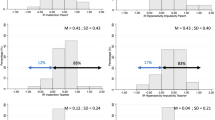Abstract
Seventeen hyperactive children who had been treated for 1–5 years with methylphenidate were studied in a double-blind placebo-controlled crossover study. Specific measures of stimulant response were found to be inversely related to the subject's level of response in the placebo condition. This inverse relationship was previously found to characterize the clinical effects of hyperactive children in an acute-treatment paradigm. It is equally valid in a chronic-treatment study. “State-contingency” is not, therefore, simply a function of the “novelty” of initial drug treatment.
Similar content being viewed by others
References
Aarskog D, Fevarg FO, Klove H, Stoa KF, Thorsten T (1977) The effect of the stimulant drugs, dextroamphetamine and methylphenidate, on secretion of growth hormone in hyperactive children. J Pediatr 90:136–139
American Psychiatric Association Task Force (1978) On nomenclature and statistics: Diagnostic and statistical manual of mental disorders (3. edn). American Psychiatric Association, Washington, DC
Barkley RA (1977) A review of stimulant drug research with hyperactive children. J Child Psychol Psychiatry 18:137–165
Barrett JE (1974) Conjuactive schedules of reinforcement. I. Rate dependent effects of pentobarbital and d-amphetamine. J Exp Anal Behav 22:561–573
Campbell SB, Douglas VI, Morgenstern G (1971) Cognitive styles in hyperactive children and the effect of methylphenidate. J Child Psychol Psychiatry 12:55–67
Charles L, Schain RJ, Guthrie D (1979) Long-term use and discontinuation of methylphenidate with hyperactive children. Dev Med Child Neurol 21:759–764
Dews PB (1955) The effects of pentobarbital, methamphetamine and scopolamine on performances in pigeons involving discrimination. J Pharmacol Exp Ther 115:380–389
Dews PB, Wenger GR (1977) Rate-dependency of the behavioral effects of amphetamine. In: Thompson T, Dews PB (eds) Advances in behavioral pharmacology. Academic Press, New York, p 167
Gal J, Hodshon BJ, Pintauro C, Flamm BL, Cho AK (1977) Pharmacokinetics of methylphenidate in the rat using single-ion monitoring GLC-mass spectrometry. J Pharm Sci 66:866–869
Glick SD, Milroy S (1973) Rate-dependent effects of d-amphetamine on locomotor activity in mice. Eur J Pharmacol 24:266–268
Gualtieri CC, Hicks RE, Mayo JP, Schroeder SR (1982) The clinical effects of methylphenidate are placebo-contingent. Ann Meet Am Acad Child Psychiatry, Washington, DC
Gualtieri CT, Wargin W, Kanoy R, Shem C, Patrick K, Youngblood W, Mueller R, Braese G (1982) Clinical studies of methylphenidate serum levels in children and adults. J Am Acad Child Psychiatry 21:19–26
Harrison JM, Abelson RM (1959) The maintenance of behavior by the termination and onset of intense noise. J Exp Anal Behav 2:23–42
Hechtmann L, Weiss G, Finkelstein J, Werner A, Benn R (1976) Hyperactives as young adults: Preliminary report. Can Med Assoc J 625–630
Hungund BL, Perel JM, Hurwie MJ, Sverd J, Winsberg BG (1979) Pharmacokinetics of methylphenidate in hyperkinetic children. Br J Clin Pharmacol 8:571–576
Lacey JL, Lacey BC (1962) The law of initial value in the longitudinal study of automatic constitution. Ann NY Acad Sci 98:1237–1290 1322–1326
Lowe TL, Cohen DJ, Detlor J, Kremenitzer MD, Shaywitz BA (1982) Stimulant medications precipitate Tourette's syndrome. JAMA 247:1729–1731
Millichap JG (1974) Neuropharmacolog of hyperkinetic behaviour: Response to methylphenidate correlated with degree of activity and brain damage. In: Vernadakis A, Weiner N (eds) Drugs and the developing brain. Plenum, New York, p 475
Mirsky AF, Gordon PV (1962) A comparison of the behavioral and physiological changes accompany: Sleep deprivation and chlorpromazine administration in man. Electroencephalogr Clin Neurophysiol 14:1–10
Puig-Antich J, Greenhill L, Sassin J, Sachar EJ (1978) Growth hormone, prolactin and cortisol responses and growth patterns in hyperactive children treated with dextro-amphetamine. J Am Acad Child Psychiatry 17:457–475
Quinn PO, Rapoport JL (1976) One year follow-up of hyperactive boys treated with imipramine on methylphenidate. Am J Psychiatry 132:241–245
Riddle KD, Rapoport JL (1976) A 2-year follow-up of 72 hyperactive boys. J Nerv Ment Dis 162:126–134
Roche AF, Lipman RS, Overall JE, Hung W (1979) The effects of stimulant medication on the growth of hyperactive children. Pediatrics 63:847–850
Routh DK, Schroeder CS, O'Tuama L (1974) Development of activity level in children. Dev Psychol 10:163–168
Shaywitz SE, Hunt RD, Jatlow P, Chohen DJ, Young JG, Pierce RN, Anderson GM, Shaywitz BA (1982) Psychopharmacology of attention deficit disorder: Pharmacokinetic, neuroendocrine, and behavioral measures following acute and chronic treatment with methylphenidate. Pediatrics 69:688–694
Sleator EK, Von Nedmann A, Sprague RL (1974) Hyperactive children, a continuous long-term placebo-controlled follow-up. JAMA 229:316–317
Weiss G, Minde K, Werry JS, Douglas V, Nemeth E (1971) Studies on the hyperactive child. VIII. Five-year follow-up. Arch Gen Psychiatry 24:409–414
Wilder J (1957) The law of initial value in neurology and psychiatry. J Nerv Ment Dis 125:73–88
Author information
Authors and Affiliations
Rights and permissions
About this article
Cite this article
Gualtieri, C.T., Hicks, R.E., Mayo, J.P. et al. The presistence of stimulant effects in chronically treated children: further evidence of an inverse relationship between drug effects and placebo levels of response. Psychopharmacology 83, 44–47 (1984). https://doi.org/10.1007/BF00427420
Received:
Accepted:
Issue Date:
DOI: https://doi.org/10.1007/BF00427420




